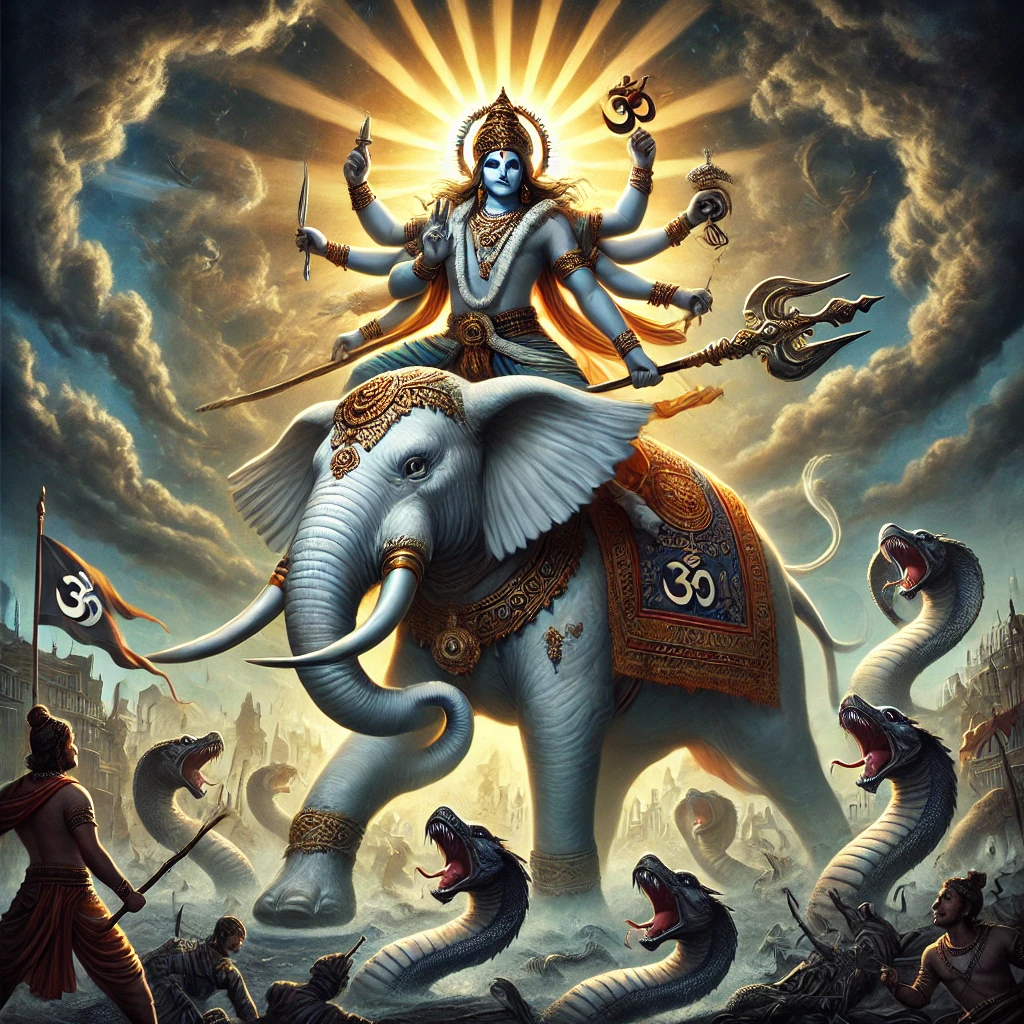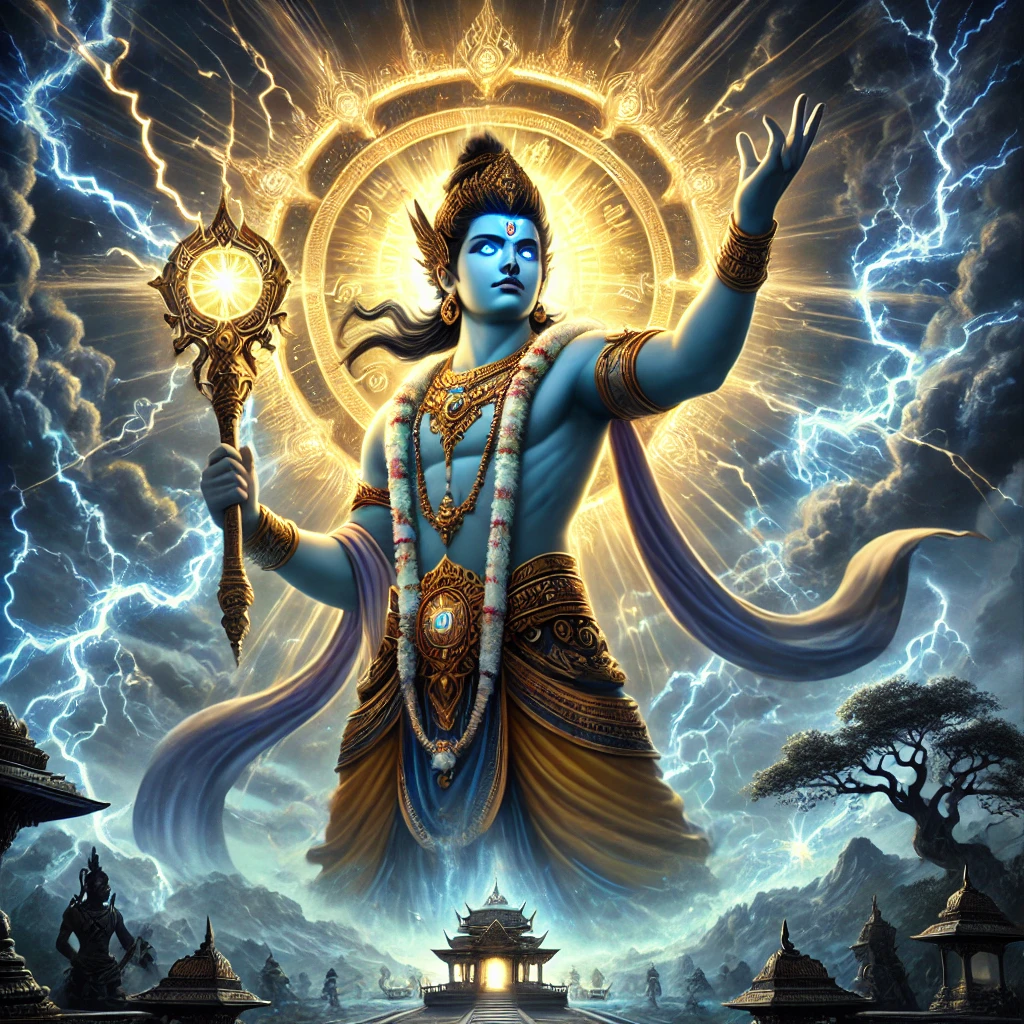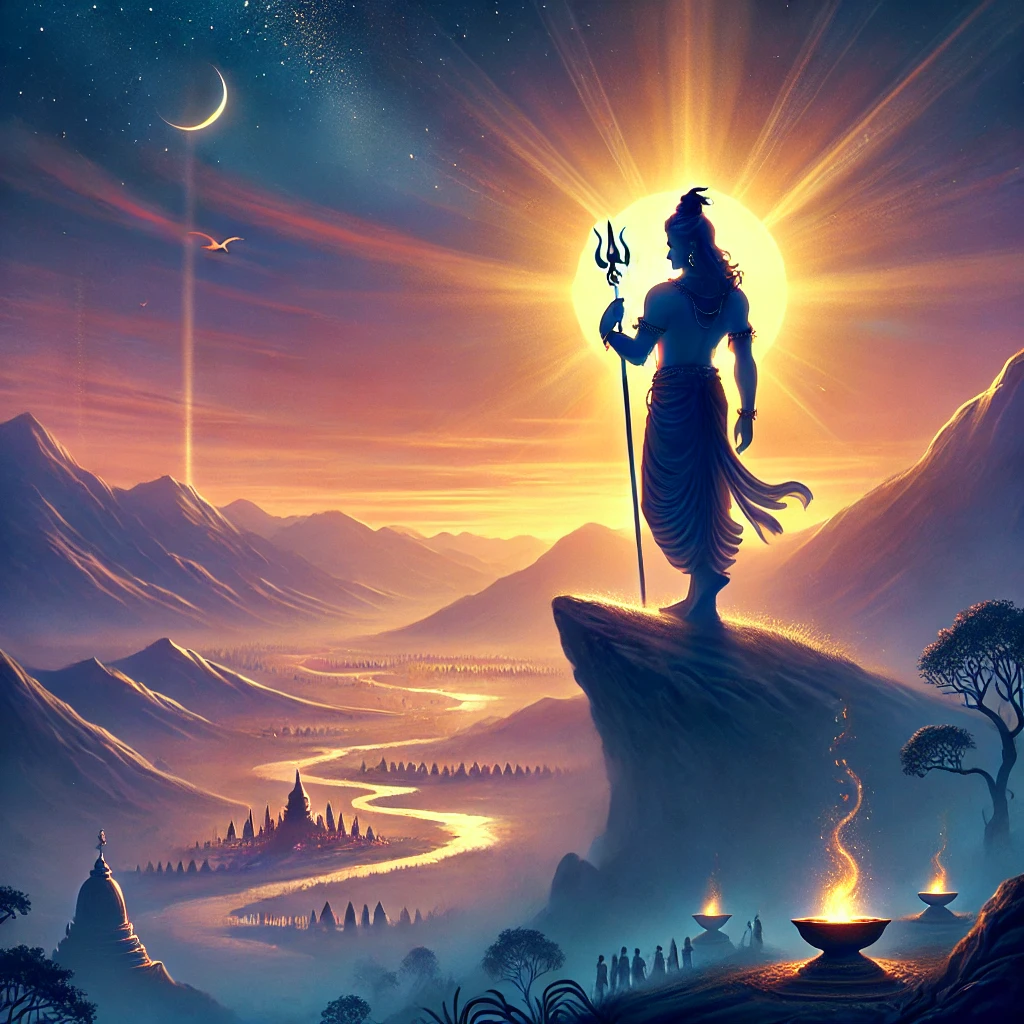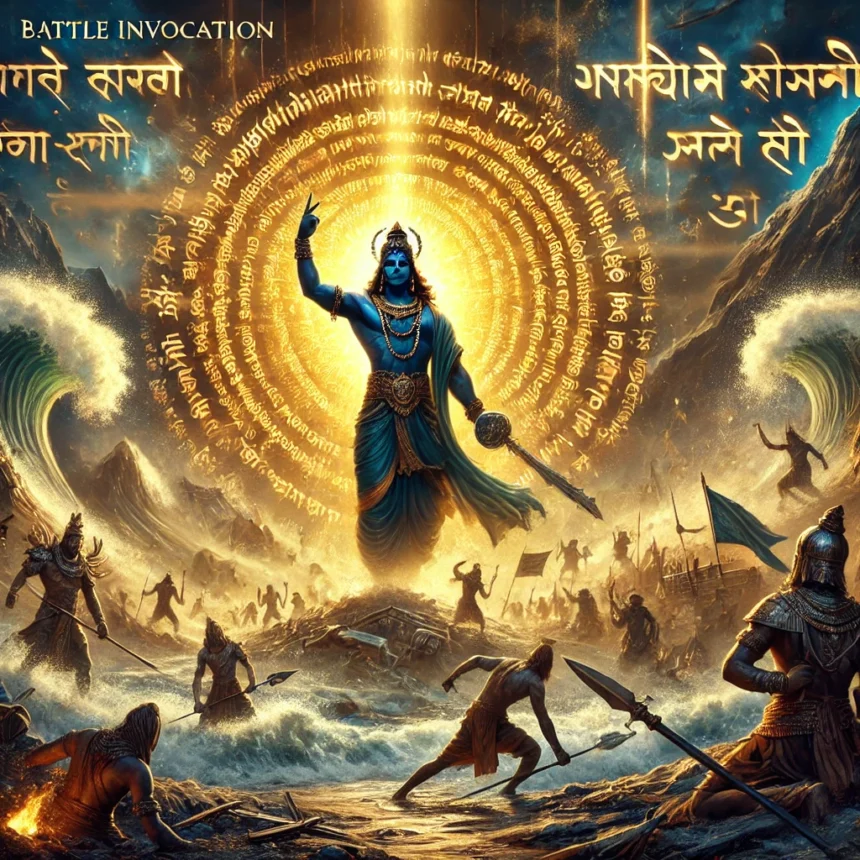Indra Suktas for Victory: Invoking the Divine Warrior Against Overwhelming Odds
Part V – Vedic Defense Mantras Series: Invocation, Not Retaliation
In our previous blogs, we exposed the danger facing Hinduism—through crisis analysis, demographic data that gives evidence to this and the introduction of a spiritual defense approach rooted in the Vedas. Subsequently we presented how Agni Suktas can be used for Vedic Defiance. The threats are not accidental but deliberate efforts to erase a 5,000-year-old civilization. Through the Vedic Defense Mantras series, we began exploring ways to respond—not with retaliation, but with divine invocation. We now turn to the Indra Suktas—invocations to the most celebrated deity in the Rigveda and the archetype of divine strength. Indra is not merely a mythic figure—he is the cosmic warrior called upon when dharma faces overwhelming odds.
With over 28o suktas dedicated to him, Indra’s presence reflects our ancestors’ understanding that defense also requires power. The Indra Suktas for Victory channel this force—invoking clarity, courage, and strength when peaceful means are no longer enough.
Understanding Indra as Divine Protector
In the context of Vedic defense, Indra represents far more than a mythological warrior god. He embodies specific cosmic principles essential for protecting dharmic civilization:
Vajra Power: Indra’s thunderbolt (vajra) represents concentrated divine force that can shatter even the strongest opposition to dharma
Victory Consciousness: As the deity who never loses, Indra provides communities with the mental strength to persist despite overwhelming challenges
Strategic Wisdom: Indra is celebrated for his tactical brilliance in overcoming seemingly impossible situations through divine intelligence
Protective Sovereignty: As king of the devas, Indra understands how to establish and maintain righteous governance against hostile forces
The Rigvedic tradition recognizes that when adharmic forces become organizationally sophisticated and systematically dangerous, communities need access to the Indra Suktas for Victory, channeling divine warrior consciousness that can match and exceed any earthly opposition..
Iconography of Indra – Symbols of Victory

Beyond the hymns, Indra’s visual symbols carry deep protective meaning in Vedic tradition. His vajra (thunderbolt) is not only a weapon but a representation of concentrated divine energy that shatters obstacles instantly. His elephant mount, Airavata, symbolizes stability, loyalty, and unstoppable forward force—qualities a community must embody in times of trial.

Indra’s association with the eastward direction connects him with the rising Sun, signifying new beginnings and illumination after darkness. Together, these images form a ritual language: invoking the Indra Suktas for Victory is not abstract philosophy but a full-bodied connection to strength, sovereignty, and the renewal of hope.

Pronunciation Guide for Sacred Mantras
Sanskrit Pronunciation Essentials
Key Terms:
- इन्द्र (Indra) – “IN-dra” (stress on first syllable)
- वज्री (vajrī) – “VAJ-ree” (thunder-wielder)
- वीर्याणि (vīryāṇi) – “VEER-ya-ni” (heroic deeds)
- अहि (ahi) – “AH-hi” (serpent/dragon)
Practice Recommendation: Begin with slow, clear pronunciation. Focus on correct vowel length (short vs. long). The mantras should flow naturally with breath, not be rushed or forced.
Rigveda 1.32 – The Vritra Victory Hymn (Complete Key Verses)
Sanskrit (Opening and Victory Verses):
इन्द्रस्य नु वीर्याणि प्र वोचं यानि चकार प्रथमानि वज्री।
अहन्नहिमन्वपस्ततर्द प्र वक्षणा अभिनत्पर्वतानाम्॥१॥
अहन्नहिं पर्वते शिश्रियाणं त्वष्टास्मै वज्रं स्वर्यं ततक्ष।
वाश्रा इव धेनवः स्यन्दमाना अञ्जः समुद्रमव जग्मुरापः॥२॥
वृषायमाणोऽवृणीत सोमं त्रिकद्रुकेष्वपिबत्सुतस्य।
आसायकं मघवादत्त वज्रमहन्नेनं प्रथमजामहीनाम्॥३॥
यदिन्द्र हन्प्रथमजामहीनामान्मायिनामामिनाः प्रोत माया।
अथ सूर्यं जनयन्द्यामुषासमादित्सा शत्रुं न किला विविंसे॥४॥
By Sri Shyama Sundara Sharma and Sri Satya Krishna Bhatta. Recorded by © 2012 Sriranga Digital Software Technologies Pvt. Ltd. [Credit: https://sri-aurobindo.co.in/]
Transliteration:
Indrasya nu vīryāṇi pra vocaṃ yāni cakāra prathamāni vajrī |
Ahann ahim anv apas tatarda pra vakṣaṇā abhinat parvatānām ||1||
Ahann ahiṃ parvate śiśriyāṇaṃ tvaṣṭāsmai vajraṃ svaryaṃ tatakṣa |
Vāśrā iva dhenavaḥ syandamānā añjaḥ samudram ava jagmur āpaḥ ||2||
Vṛṣāyamāṇo ‘vṛṇīta somaṃ trikadrukṣv apibat sutasya |
Āsāyakaṃ maghavād atta vajram ahann enaṃ prathamajām ahīnām ||3||
Yad indra han prathamajām ahīnām ān māyināṃ āminā prota māyā |
Atha sūryaṃ janayan dyām uṣāsam ādit sā śatruṃ na kilā viviṃse ||4||
Essential Meaning:
“I will declare the manly deeds of Indra, the first that he achieved, the Thunder-wielder. He slew the serpent, then disclosed the waters, and cleft the channels of the mountain torrents.
He slew the dragon lying on the mountain: his heavenly bolt of thunder Tvaṣṭar fashioned. Like lowing kine in rapid flow descending the waters glided downward to the ocean.
Impetuous as a bull, he chose the Soma and in three sacred beakers drank the juices. Maghavan grasped the thunder for his weapon, and smote to death this firstborn of the dragons.
When, Indra, thou hadst slain the dragon’s firstborn, and overcome the charms of the enchanters, then, giving life to Sun and Dawn and Heaven, thou foundest not one foe to stand against thee.”
Breaking Maya – The Psychological Victory:
Verse 4 highlights Indra’s triumph over Maya—the deceptive enchantments of hostile forces. Ancient seers saw this as more than physical victory; it symbolized liberation from manipulation, false narratives, and mental colonization. For modern communities, this translates to breaking cycles of ideological suppression or distorted history that weaken dharmic confidence. Indra consciousness thus equips not only for material defense but also for psychological clarity—dissolving illusions that adversaries use to dominate.
Key Concept:
This foundational Indra sukta celebrates his cosmic victory over Vritra, the demon of obstruction and drought. The hymn establishes Indra’s power to overcome forces that would block the flow of life and prosperity to dharmic communities.
Protection Application:
Communities facing coordinated efforts to cut off their resources, restrict their religious practices, or systematically isolate them from broader society can turn to the Indra Suktas for Victory to break through such obstructions.
Historical Echoes:
This is not merely symbolic. During colonial restrictions on Hindu temple entry, dharmic communities invoked such suktas to maintain courage and spiritual resilience until reforms opened pathways again. Similarly, during the partition era, when displacement and systematic targeting threatened cultural continuity, recitation of Indra suktas offered strength and solidarity that helped sustain refugee communities through impossible odds. These historical moments demonstrate how the Indra Suktas for Victory functioned as spiritual arsenals—not of retaliation, but of survival, cohesion, and hope.
Traditional Understanding:
Ancient seers recognized that some threats to dharma come not through direct violence but through systematic strangulation of communities’ ability to thrive and maintain their traditions.
Rigveda 2.12 – The Divine Attributes Hymn
Sanskrit (Opening Verses):
यो जात एव प्रथमो मनस्वान्देवो देवान्क्रतुना पर्यभूषत्।
यस्य शुष्माद्रोदसी अभ्यसेतां नृम्णस्य मह्ना स जनास इन्द्रः॥१॥
यो अन्तरिक्षे रजसो विमानो महो दिवः स्तबायद्गभीरैः।
यो वि ममे पृथिवीं स्यामुरुर्वीं तद्दाधार सूर्यं दिवं च॥२॥
यो हत्वाहिमन्वपस्ततर्द यो गा उदाजदपधा वलस्य।
यो अश्मनोरन्तर अग्निं जजान संवृक् समत्सु स जनास इन्द्रः॥३॥
By Sri Shyama Sundara Sharma and Sri Satya Krishna Bhatta. Recorded by © 2012 Sriranga Digital Software Technologies Pvt. Ltd. [Credit: https://sri-aurobindo.co.in/]
Transliteration:
Yo jāta eva prathamo manasvān devo devān kratunā paryabhūṣat |
Yasya śuṣmād rodasī abhyasetāṃ nṛmṇasya mahnā sa janāsa indraḥ ||1||
Yo antarikṣe rajaso vimāno maho divaḥ stabāyad gabhīraiḥ |
Yo vi mame pṛthivīṃ syām ururvīṃ tad dādhāra sūryaṃ divaṃ ca ||2||
Yo hatvāhim anv apas tatarda yo gā udājad apadhā valasya |
Yo aśmanor antar agniṃ jajāna saṃvṛk samatsu sa janāsa indraḥ ||3||
Essential Meaning:
“He who, just born, first among the wise, became by his power the protector of the gods. Before whose might through greatness of his valor the two worlds trembled – He, O men, is Indra.
He who made firm the earth that tottered, and set at rest the agitated mountains, who measured out the air’s wide middle region and gave the heaven support – He, O men, is Indra.
Who slew the dragon, freed the seven rivers, and drove the cattle forth from Vala’s stronghold, who generated fire between two stones, the spoiler in warriors’ battle – He, O men, is Indra.”
Traditional Content:
This systematic hymn proclaims Indra’s supreme cosmic functions – stabilizing the universe, defeating hostile forces, and establishing cosmic order. Each verse follows the pattern “He who… – He, O men, is Indra,” emphasizing his definitive role as cosmic protector.
Protection Application:
When communities face direct persecution or organized campaigns against their existence, these verses help align consciousness with divine justice and protective power. The systematic enumeration builds confidence in Indra’s comprehensive protective capabilities.
Modern Relevance:
Particularly applicable when legal, social, or political systems fail to protect Hindu communities—moments when the Indra Suktas for Victory become a vital resource against systematic targeting or demographic manipulation.
Rigveda 8.51-8.53 – Divine Victory Trilogy
Sanskrit (Authentic Verses from Dr. Ganga Sahaya Sharma Edition):
सत्यमिद्वा उ तं वयमिन्द्र स्तवाम नानृतम्।
महाँ असुन्वतो वधो भूरि ज्योतींषि सुन्वतो भद्रा इन्द्रस्य रातयः॥RV 8.51.12॥
यत्पाञ्चजन्यया विशेन्द्रे घोषा असृक्षत।
अस्तुग्राद् बहुणा विपो ऽयों मानस्य य क्षयः॥RV 8.52.7॥
उत्वा मन्दन्तु स्तोमाः कृणुष्व राधो अद्रिवः।
अव ब्रह्मद्विषो जहि॥RV 8.53.1॥
[Unfortunately, we can not present the audios for these slokas as they are not available publicly and we have no resources to chant as per the correct phonetics]
Transliteration:
Satyamidvā u taṃ vayam indra stavāma nānṛtam |
Mahāṃ asunvato vadho bhūri jyotīṃṣi sunvato bhadrā indrasya rātayaḥ ||RV 8.51.12||
Yatpañcajanyayā viśendre ghoṣā asṛkṣata |
Astugrād bahuṇā vipo a’syoṃ mānasya ya kṣayaḥ ||RV 8.52.7||
Utvā mandantu stomāḥ kṛṇuṣva rādho adrivaḥ |
Ava brahmadviṣo jahi ||RV 8.53.1||
Essential Meaning (Based on Dr. Sharma’s Commentary):
Truth in Divine Praise: “We will certainly praise Indra truthfully, we will not speak falsehood. Indra destroys those who do not extract Soma-juice and gives abundant light to those who extract Soma-juice. Indra’s gifts are auspicious.(RV 8.51.12)“
Universal Victory Proclamation: “When the four varnas and Nishaad people praise Indra together, then Lord Indra, through his glory, destroys enemies and becomes worthy of reverence of the wise. (RV 8.52.7)“
Direct Enemy Elimination: “O Vajra-wielding Indra! Let the praises please you greatly. Grant us wealth and destroy the Brahmana-haters. (RV 8.53.1 )“
Traditional Content:
This trilogy from RV 8.51-8.53 represents a complete system for invoking divine victory through truthful worship, universal support, and direct elimination of dharma-destroyers. The progression moves from establishing sincere devotion (8.51.12) through building collective strength (8.52.7) to requesting targeted action against enemies of dharmic culture (8.53.1).
Key Conceptual Elements:
- Truthful Invocation (satyam indra stavāma – we praise Indra truthfully): Emphasis that effective divine intervention requires sincere worship rather than mere ritual performance
- Universal Coalition (pañcajanyayā viśendre – all peoples with Indra): Recognition that dharmic protection becomes most powerful when all dharma-supporting communities unite in invocation
- Targeted Divine Action (brahmadviṣo jahi – destroy Brahmana-haters): Specific request for elimination of those who systematically oppose Vedic culture and dharmic learning
- Light vs. Darkness Principle (bhūri jyotīṃṣi sunvato – abundant light to Soma-extractors): Divine blessing flows to those who maintain sacred practices while destruction comes to those who abandon them
Protection Application:
This trilogy provides a systematic approach to divine intervention during cultural and spiritual warfare:
Foundation Building (8.51.12): Establishes sincere devotional practice as the prerequisite for divine support, emphasizing that Indra responds to truthful worship and automatically destroys those who abandon sacred practices.
Coalition Strengthening (8.52.7): Calls for unity among all dharma-supporting communities (pañcajanyā – all five peoples) in collective praise, creating the social foundation necessary for sustained divine protection.
Enemy Elimination (8.53.1): Directly requests divine action against brahmadviṣaḥ (those who hate Brahmanas/dharmic learning), representing systematic opponents of Vedic culture and traditional knowledge.
Historical Context:
These verses were employed during periods when Vedic communities faced coordinated attacks on their religious and cultural foundations. The specific mention of brahmadviṣaḥ (Brahmana-haters) indicates protection against those who systematically target dharmic learning, sacred knowledge, and traditional priesthood.
Modern Relevance:
Directly applicable to contemporary situations where Hindu communities face systematic targeting of their cultural institutions, traditional learning, and dharmic practices. The verses address both the need for internal unity among dharma-supporters and divine intervention against organized cultural destruction efforts.
Community Application:
The Divine Victory Trilogy serves as a comprehensive spiritual warfare system for communities facing existential threats to their dharmic civilization. Unlike individual protection mantras, these verses invoke divine intervention at the cultural and civilizational level.
Implementation Protocols:
Daily Foundation Practice:
- Morning: RV 8.51.12 (establishing truthful devotion and divine discrimination)
- Midday: RV 8.52.7 (building community unity and collective strength)
- Evening: RV 8.53.1 (requesting direct action against dharma-destroyers)
Crisis Intensification: During periods of active cultural persecution or systematic targeting of Hindu institutions, recite all three verses in sequence, repeated 108 times, while visualizing Indra’s vajra destroying hostile forces and protecting dharmic communities.
Community Coordination: Coordinate neighborhood and regional recitation during periods of heightened threat, with different communities taking responsibility for different verses while maintaining synchronized timing across geographic areas for maximum collective protective impact.
Traditional Timing:
- New Moon: Maximum power for elimination of enemies (emphasis on 8.53.1)
- Full Moon: Optimal for community building and collective strength (emphasis on 8.52.7)
- Solar Transitions: Enhanced effectiveness for establishing divine connection (emphasis on 8.51.12)
Source Authentication:
Rigveda by Dr. Ganga Sahaya Sharma, M.A. (Hindi-Sanskrit), P-Ph.D., Vyakarancharya. Sanskrit Sahitya Prakashan. Traditional Sanskrit manuscript edition with authentic verse numbering and preservation.
Advanced Indra Suktas for Victory: Protection Practices for Dharmic Resilience
Community Warrior Consciousness
Indra suktas awaken a collective state of readiness within communities. This begins with shared invocation—reciting together during times of threat, reinforcing unity, and aligning decisions with divine warrior principles. The focus is on collective resolve: organizing resources, coordinating responses, and ensuring that no family stands alone. When communities gather under Indra consciousness, their strength multiplies far beyond individual effort.
Dharmic Leadership Development:
The Indra suktas provide frameworks for developing leaders who can guide communities through periods of extreme challenge while maintaining dharmic principles and spiritual integrity.
Strategic Spiritual Defense
Indra Suktas for Victory as Intelligence and Planning:
- Using Indra consciousness to develop effective community strategies
- Divine guidance for recognizing and countering sophisticated threats
- Spiritual preparation for leaders making critical decisions
- Accessing cosmic perspective on complex threatening situations
Organizational Strength:
- Building community resilience through shared warrior spirituality
- Developing networks of mutual support among dharmic communities
- Creating systems that can withstand coordinated external pressure
- Establishing sustainable defense capabilities rooted in spiritual practice
Implementation for Modern Threats
Demographic Defense Applications
Community Coordination: Community Coordination: When facing systematic demographic manipulation, communities can use the Indra Suktas for Victory to develop:
- Unified response strategies based on dharmic principles
- Leadership capable of making difficult but necessary decisions
- Community solidarity that transcends individual differences
- Access to divine guidance for complex survival challenges
Resource Protection:
- Spiritual preparation for economic or social boycotts
- Divine support for maintaining community institutions under pressure
- Cosmic assistance for accessing alternative resources when traditional sources are compromised
- Strategic wisdom for long-term community sustainability
Legal and Political Applications
Dharmic Justice:
- Invoking cosmic justice when human legal systems fail to protect
- Divine support for legal strategies and political advocacy
- Spiritual strength for leaders engaging hostile institutions
- Community unity during extended legal or political struggles
Institutional Protection:
- Divine assistance for preserving temples, schools, and cultural institutions
- Cosmic support for maintaining religious practices under pressure
- Strategic wisdom for navigating hostile bureaucratic systems
- Spiritual preparation for institutional leadership during crises
Ethical Framework and Limitations
Righteous Application Only
Dharmic Boundaries:
- Indra suktas must only be used for genuine community protection
- Never employ these practices for personal gain or revenge against individuals
- Focus intention on protecting dharma, not destroying specific people
- Maintain compassion even while seeking divine intervention against threats
Community Responsibility:
- Leaders using these practices must be committed to dharmic principles
- Decisions made under Indra consciousness must serve genuine community welfare
- Power accessed through these suktas requires corresponding spiritual development
- Community oversight ensures practices serve righteous rather than political purposes
Traditional Warnings
Spiritual Prerequisites:
- Dharmic Foundation: A clear understanding of dharmic principles is essential before accessing Indra’s warrior consciousness.
- Purification First: Regular Agni sukta practice provides the necessary base of clarity and purity.
- Non-Violence Principle: Even while opposing harmful systems, intention must remain free of hatred toward individuals.
- Integrated Growth: Warrior consciousness should grow alongside broader spiritual development, not as a standalone pursuit.
Collective Safeguards:
- Community elders should guide major applications of these practices
- Multiple qualified practitioners should confirm appropriate usage
- Regular review ensures practices remain aligned with dharmic principles
- Integration with traditional ethical frameworks prevents misuse
Building Warrior Consciousness
Individual Preparation
Personal Foundation:
- Establish daily Agni practices before beginning Indra work
- Develop deep study of dharmic principles and community welfare
- Cultivate personal courage through spiritual practice and understanding
- Build capacity for making difficult decisions based on dharmic principles
Mental Training:
- Practice maintaining calm determination under pressure
- Develop ability to see beyond immediate circumstances to cosmic justice
- Build confidence in divine support for righteous causes
- Strengthen resolve to protect community even at personal cost
Community Development
Leadership Training:
While community resolve provides the base, leadership ensures direction. The Indra suktas offer a framework for nurturing dharmic leaders who can act with clarity under pressure. Training emphasizes spiritual grounding, ethical decision-making, and the ability to access divine guidance when facing complex crises. These leaders do not dominate but serve—holding the community steady, making difficult choices, and carrying forward the warrior consciousness in practice.
Collective Practice:
- Regular community gatherings for Indra sukta study and practice
- Coordination between families for mutual protection and support
- Development of communication systems for times of crisis
- Integration of spiritual defense with practical community organization
Integration with Daily Life
Ongoing Spiritual Development
Regular Practice:
- Weekly Indra sukta recitation for community strength
- Monthly community gatherings focused on protective consciousness
- Seasonal intensification during periods of increased threat
- Annual community renewal of commitment to dharmic defense
Family Implementation:
- Teaching children about righteous courage and community protection
- Family discussions about dharmic principles in challenging situations
- Household practices that build confidence in divine support
- Integration of protective consciousness into daily spiritual routines
Community Resilience
Institutional Development:
- Religious institutions incorporating protective consciousness into programs
- Educational systems teaching dharmic response to community challenges
- Economic cooperation ensuring community sustainability under pressure
- Cultural preservation through spiritually grounded community organization
Network Building:
- Connections with other communities practicing Vedic defense
- Sharing of knowledge and mutual support during difficult periods
- Coordination of responses to threats affecting multiple communities
- Development of broader movement for dharmic community protection
Advanced Applications
Advanced Applications of Indra Suktas for Victory
The hymns of Indra are not only for immediate protection; they also provide blueprints for long-term resilience. Advanced applications focus on three areas: crisis readiness, generational continuity, and regional coordination.
1. Crisis Response Systems
Communities must be able to respond swiftly when under direct threat. Indra consciousness provides the energy for:
-
Rapid Mobilization: Organizing people and resources quickly during emergencies.
-
Succession Planning: Preparing future leaders to step in during persecution or upheaval.
-
Resource Sharing: Ensuring systems exist to provide essentials when external access is blocked.
-
Secure Communication: Maintaining reliable coordination even under pressure.
2. Long-Term Strategies for Resilience
Protection is not only for the present but also for future generations. Indra suktas encourage:
-
Multi-Generational Planning: Ensuring survival and flourishing across centuries.
-
Education for Leadership: Training young people to make dharmic decisions under pressure.
-
Cultural Preservation: Safeguarding traditions and practices beyond individual lifespans.
-
Spiritual Transmission: Keeping protective knowledge alive through lineage and teaching.
3. Regional Coordination
No community stands alone. Advanced application requires building alliances:
-
Neighborhood Protection Networks: Coordinating defense and welfare locally.
-
Regional Gatherings: Sharing knowledge and practices across communities.
-
Collective Spiritual Practice: Invoking Indra together for large-scale protection.
-
Dharmic Legal & Political Unity: Acting jointly with wisdom in the face of hostile systems.
Moving Forward in the Series
Moving Forward in the Series
The Indra Suktas for Victory remind us that protection of dharma is never an individual task—it is a shared calling. They show that even against overwhelming odds, communities can draw upon cosmic warrior strength, break through deception, and stand unshaken in their resolve. Indra’s hymns do not call for conquest, but for courage, clarity, and righteous defense when survival itself is at stake.
As this series continues, we turn to the Marut suktas, where Indra’s cosmic allies embody the storm-force of collective action. If Indra represents the warrior’s unyielding spirit, the Maruts represent the power of many—an army of voices, hearts, and wills united for protection.
Let us carry forward this strength together: cultivating warrior consciousness within, standing firm in our communities, and preparing to call upon the storm-forces when dharma demands it.
Next in this series: “Marut Suktas for Collective Defense: Mobilizing Divine Storm Forces Against Civilizational Threats” – where we learn to coordinate with the divine armies that protect entire civilizations.
Feature Image: Click here view the image.
Glossary of Terms
-
Agni Suktas: Rigvedic hymns dedicated to Agni, the fire deity, symbolizing purification, transformation, and protection.
-
Adharmic: Actions or forces that oppose dharma (cosmic order, righteousness, and moral duty).
-
Airavata: The divine white elephant that serves as Indra’s mount, symbolizing strength, loyalty, and stability.
-
Ahi: A serpent or dragon, often associated with Vritra, the demon of drought and obstruction in the Rigveda.
-
Dharma: The principle of cosmic order, righteousness, and moral duty that sustains both individual and collective life.
-
Dharma Yuddha: A righteous war or struggle fought in defense of dharma, often spiritual and moral rather than merely physical.
-
Indra: The Vedic king of the gods (devas), divine warrior, and wielder of the vajra (thunderbolt). Protector of cosmic order and vanquisher of Vritra.
-
Indra Suktas for Victory: Rigvedic hymns dedicated to Indra, invoked for strength, protection, and resilience in the face of overwhelming opposition.
-
Maghavan: An epithet of Indra, meaning “the bountiful” or “the generous giver.”
-
Maya: In Vedic usage, refers to illusion or deceptive power, often used by adversaries of the gods. Indra’s triumph over Maya symbolizes victory over manipulation and falsehood.
-
Rigveda: The oldest of the four Vedas, composed in Sanskrit, containing over 1,000 hymns (suktas), including the Indra suktas.
-
Soma: A sacred ritual drink and plant praised in the Vedas, consumed by gods and priests for strength and divine inspiration.
-
Sukta: A hymn or collection of verses in the Rigveda. Each sukta is dedicated to a particular deity or cosmic principle.
-
Tvaṣṭar: The divine artisan or craftsman of the Vedic pantheon, credited with forging Indra’s vajra (thunderbolt weapon).
-
Vajra: The thunderbolt weapon wielded by Indra, symbolizing unbreakable divine force and decisive power against obstacles.
-
Vritra: The serpent-demon of drought and obstruction slain by Indra, whose defeat released the rivers and restored cosmic balance.
-
Vṛtrahaṇ: A title of Indra, meaning “slayer of Vritra,” emphasizing his role as destroyer of cosmic obstructions.
-
Victory Consciousness: A concept in the blog referring to Indra’s archetype as the undefeated divine warrior, instilling resilience in communities.
-
Yajña: A Vedic sacrificial ritual involving offerings into fire, often accompanied by recitation of mantras for divine blessings and protection.
#Indra #Rigveda #Vedas #HinduinfoPedia #Dharma #Suktas, #Victory, #Dharma, #Community, #Protection
Previous Blogs of the Series
- https://hinduinfopedia.org/civilization-under-siege-why-hindu-communities-face-an-existential-crisis/
- https://hinduinfopedia.org/crisis-documented-mathematical-evidence-of-systematic-hindu-elimination/
- https://hinduinfopedia.org/vedic-defense-mantras-rigvedas-protection-against-threats/
- https://hinduinfopedia.org/agni-suktas-for-protection-invoking-divine-fire-against-adharmic-forces/
Later Blogs
- https://hinduinfopedia.org/hymns-of-safeguard-an-ancient-armory-for-modern-crisis/
- https://hinduinfopedia.org/ashvini-kumar-suktas-for-divine-rescue-and-healing/
- https://hinduinfopedia.org/rigvedic-hymns-a-deeper-look-at-divine-protection/
- https://hinduinfopedia.org/vedic-defense-through-rigveda-richas-a-deeper-look-at-divine-protection/
- https://hinduinfopedia.org/mantras-for-defense-hardcore-rigvedic-protection-against-spiritual-disturbances/



Leave a Reply